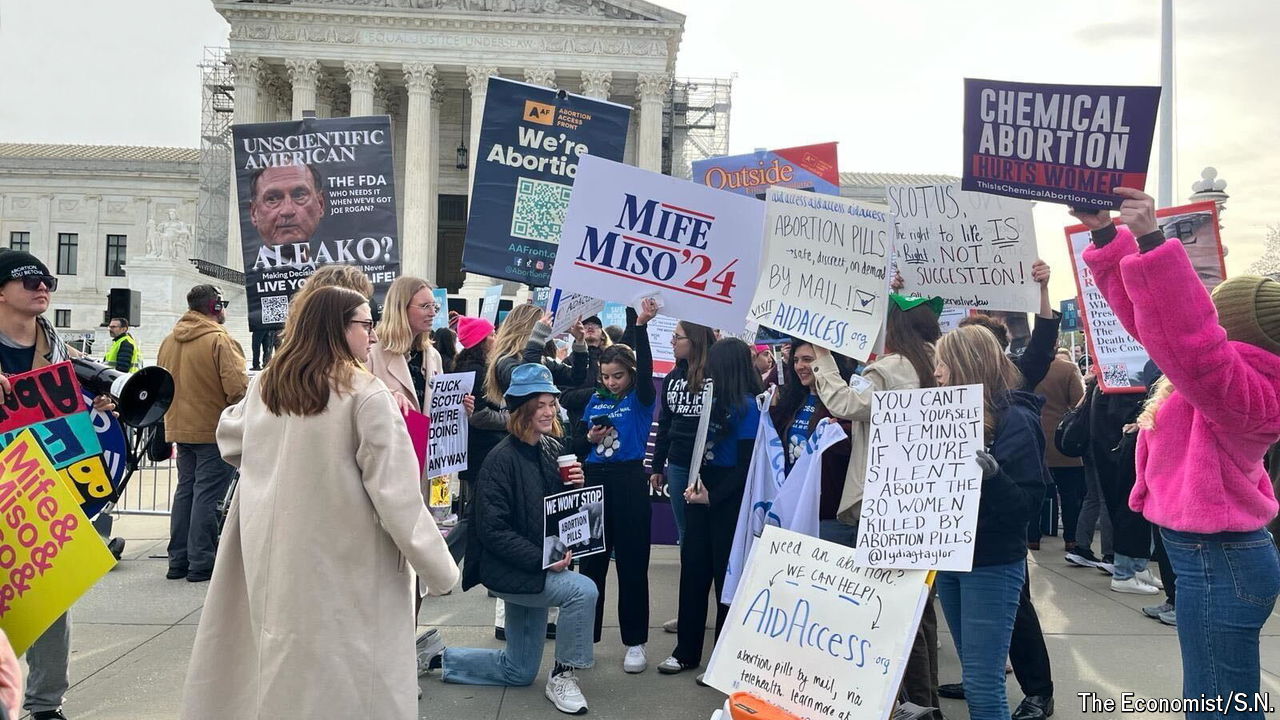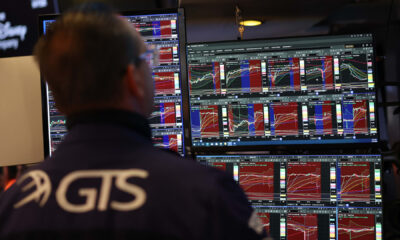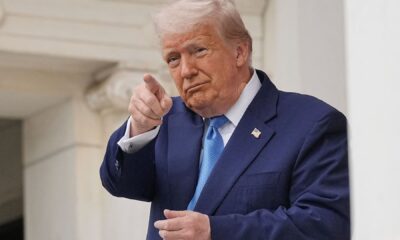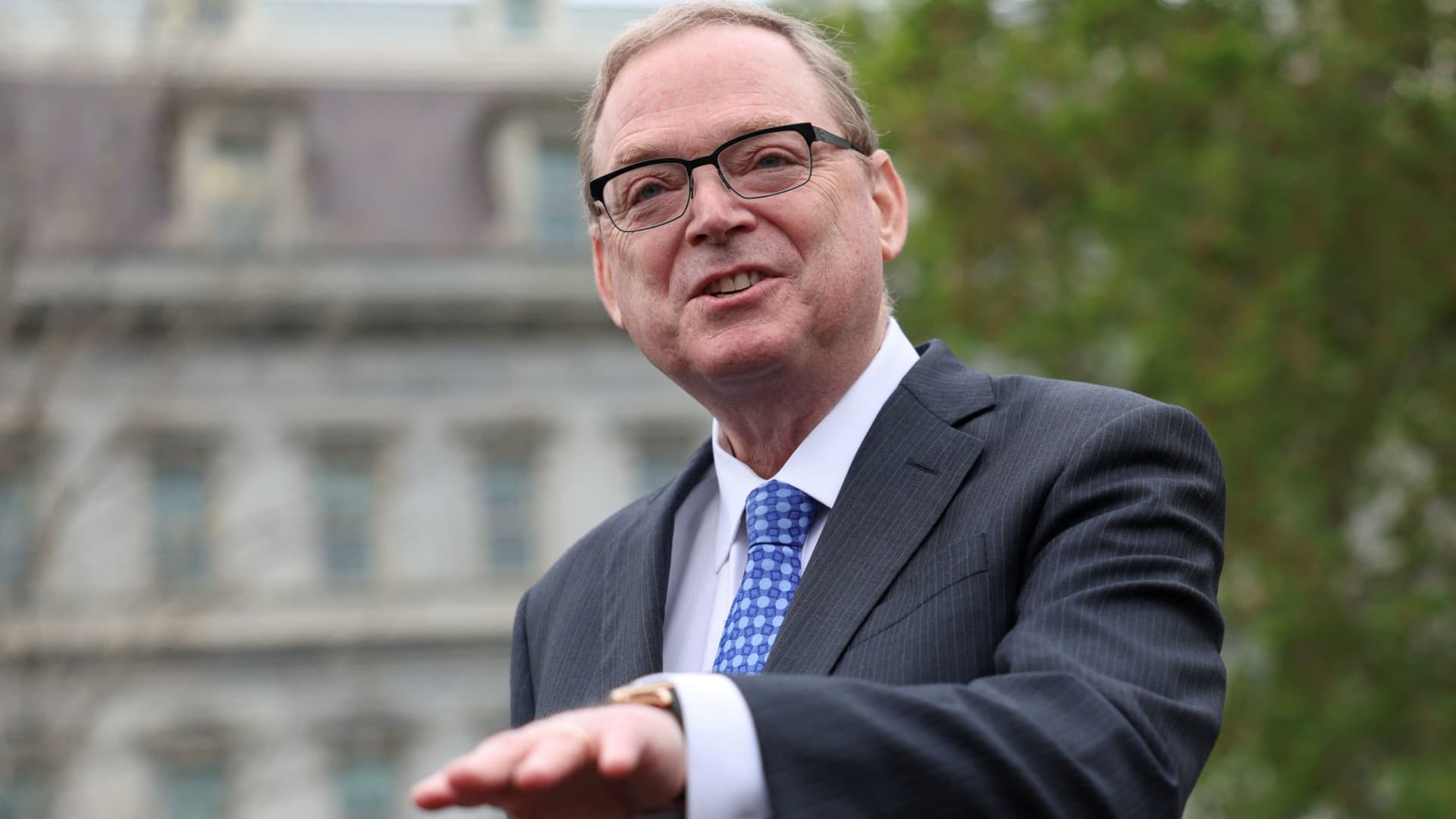ANTI-ABORTION ACTIVISTS were thrilled when Donald Trump won the presidency in 2016. Mr Trump had promised to appoint justices who would “automatically” overturn Roe v Wade, the 1973 case that protected reproductive rights. Three appointments later, the Supreme Court did just that in Dobbs v Jackson Women’s Health Organisation. But two years on, an oral argument on March 26th concerning mifepristone—a medication used in 63% of abortions in America—bodes ill for those hoping the court will help them keep limiting access to abortion care. At least for now.
Food and Drug Administration v Alliance for Hippocratic Medicine concerns a challenge to mifepristone by a group of doctors who oppose abortion. They persuaded a lower-court judge to de-authorise the FDA’s approval of the drug in 2000 despite a safety record comparable to Tylenol (paracetamol) and penicillin. The Fifth Circuit Court of Appeals somewhat softened that slap in the agency’s face last August. But it blocked the FDA’s moves in 2016 and 2021 allowing mifepristone to be used later in pregnancy (through ten weeks) and to be sent through the mail with a remote prescription.
Erin Hawley, representing the plaintiffs, defended the pill restrictions in her first argument at the Supreme Court. With her husband, Senator Josh Hawley, watching from the public gallery, she told the justices that the FDA’s policy on mifepristone left her clients facing a “Hobson’s choice”. Forcing doctors either to stand by their beliefs or care for a woman who took abortion pills and wound up in the emergency room, Ms Hawley said, is “intolerable”. Yet she faced deeply sceptical questioning from justices across the ideological spectrum as to whether her clients had suffered a concrete injury—a prerequisite for bringing a lawsuit in the first place.
Colloquy about “standing”, or a lack thereof, consumed perhaps three-quarters of the 90-minute hearing. Justices Elena Kagan and Amy Coney Barrett teamed up to demonstrate that even Ms Hawley’s two exemplars—Dr Christina Francis and Dr Ingrid Skop—had not suffered a concrete injury. Dr Francis may have had a patient who needed surgical attention after a complication from taking mifepristone, but she never raised an objection to treating her, Justice Kagan pointed out. And as Justice Barrett noted, it was actually her partner who performed the procedure, not Dr Francis herself: “I don’t read either Skop or Francis” as having “ever participated” in ending the life of a fetus or embryo.
The Alliance offered an alternative account of why the Alliance may have the right to sue—a theory known as “associational standing”. This is when an organisation brings a lawsuit based on harm to the organisation itself or to its members. Justice Clarence Thomas noted that it may be too “easy to manufacture” an injury rooted in an organisation’s bare opposition to a policy if all it has to show is “diverted time and resources” associated with bringing the lawsuit. Meanwhile, Justice Samuel Alito suggested that the court has been flexible with standing in past cases and seemed exasperated by the possibility that no one could come up with a plausible plaintiff. “Is there anybody who can sue and get a judicial ruling on whether what FDA did was lawful?” he asked. “Shouldn’t somebody be able to challenge that in court?” That’s quite unlikely, replied Elizabeth Prelogar, the solicitor-general who ably defended the FDA’s moves. But in any case, the plaintiffs in court don’t “come within a hundred miles” of the Supreme Court’s long-standing standards.
Several justices explored Ms Prelogar’s claim that federal law provides “conscience protections” that “would guard against the injury the doctors face”. Justices Barrett and Brett Kavanaugh seemed satisfied with her assurance that the government would not force a doctor with an objection to ending fetal life to participate in an abortion. Justice Ketanji Brown Jackson added that the “obvious common-sense remedy” is to give individual doctors “an exemption” (which they already have) rather than, as she said to Ms Hawley, to “entertain your argument that no one else…in America should have this drug in order to protect your clients”.
Justice Neil Gorsuch jumped on this suggestion. Single-judge district courts, he lamented, too often refashion themselves as “a nationwide legislative assembly” when blocking actions of the federal government. The judiciary’s proper role, he said, is to “provide a remedy sufficient to address the plaintiff’s asserted injuries and go no further”.
Two justices seem ready to go significantly further. Justices Alito and Thomas invoked the Comstock Act, a law from 1873 that bans sending, among other “lewd” things, abortion medications and materials through the post. In 2022 the White House’s Office of Legal Counsel said that this 150-year-old law only prohibits posting such materials to people who will use them unlawfully. But Justice Alito was incredulous that the FDA did not at least mention the law when regulating mifepristone. And Justice Thomas told Jessica Ellsworth, the lawyer for Danco Laboratories (which markets the drug as Mifeprex) that it “specifically covers drugs such as yours”.
If three more justices who were mum on this 19th-century law have a similar view, a future administration could succeed in banning the posting of abortion medication. But for now, it seems, the nearly 650,000 American women who end their pregnancies each year with abortion pills will not see their access curtailed.
Visitors outside the Supreme Court on March 26th saw just how convenient mifepristone can be. Foot-high “Roe-bots” whizzed around the plaza ready to distribute abortion pills by prescription. Controlled by doctors in Massachusetts, New York and Washington, the bots can do a virtual consultation with a remote provider and dispense the medication on demand. A volunteer with Aid Access, the charity which organised the demonstration, noted the Roe-bots were perfectly legal. “It’s all very by the book,” she said. ■

 Accounting1 week ago
Accounting1 week ago
 Economics1 week ago
Economics1 week ago
 Personal Finance1 week ago
Personal Finance1 week ago
 Accounting1 week ago
Accounting1 week ago
 Finance1 week ago
Finance1 week ago
 Economics1 week ago
Economics1 week ago
 Economics1 week ago
Economics1 week ago
 Economics1 week ago
Economics1 week ago






















